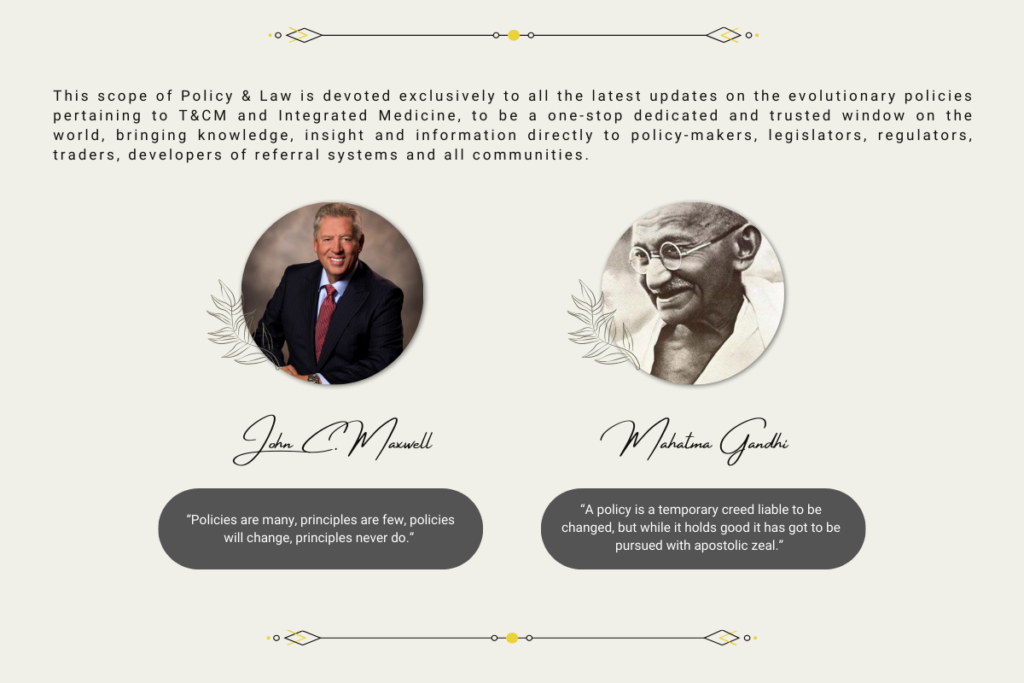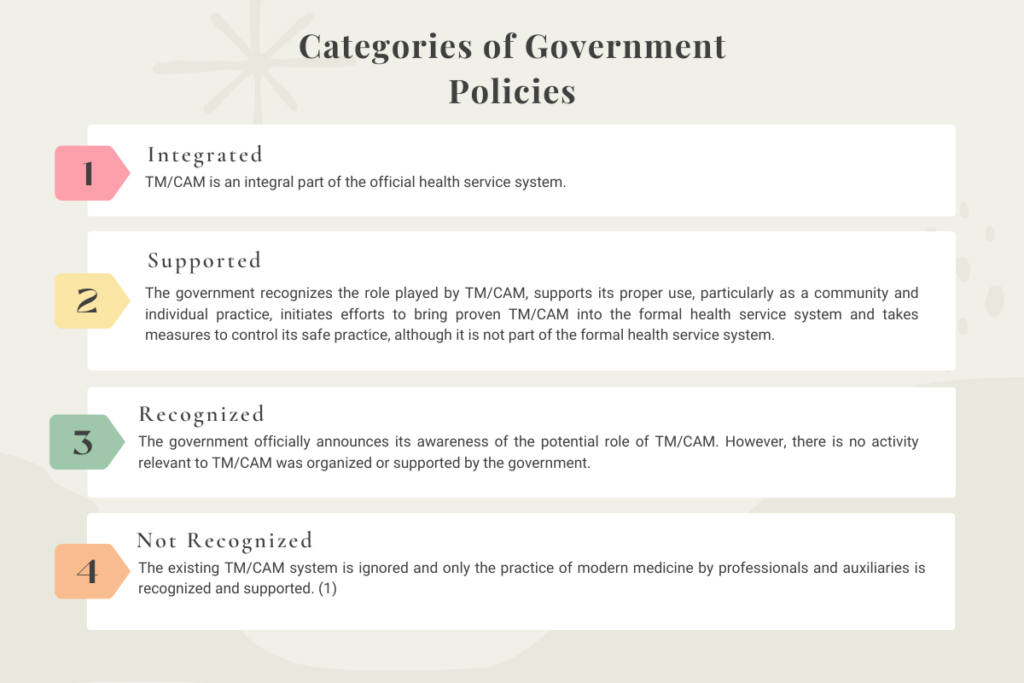
What is Policy?


Policy Related To TM/CAM
According to World Health Organisation (WHO) Traditional Medicine (TM) strategy 2002-2005 (in press), the National Policy on Traditional Medicine/Complementary and Alternative Medicine (TM/CAM) can be defined as “A national policy on TM/CAM could include some of the following key elements: a definition of TM/CAM, provision for the creation of laws and regulations, consideration of intellectual property issues, etc. The policy could further contain main strategies proposed by the government for achieving the objectives of the policy.”
Different categories of government policies related to TM/CAM in existence may be summarized as follows:

Importance of Policy Related To TM/CAM
In order to introduce measures for regulation and control of TM, a government policy is needed which requires, as a first step, a clear statement on the role of TM in health care. For this reason, the extent of governments’ involvement and the relationship between TM and formal health services requires a clear definition in order to develop a programme that might result in establishing a system to guarantee the safe and effective application of TM.(1)
A growing number of countries are adopting national policies on TM and developing specific regulatory capacity, especially for herbal medicines. The use of TM is widespread in some countries and is the only available form of health care system in others. Increasingly, countries are defining the role that TM plays in national health care delivery systems. Scientific evidence from randomized clinical trials is strong for many uses of acupuncture, for some herbal medicines and for some of the manual therapies. Nevertheless, much of the scientific literature on TM provides inadequate evidence on safety and efficacy: individual case reports and patient series, with no control or comparison group. Over-harvesting of medicinal plants threatens some ecosystems. Protection and preservation of TM knowledge is essential to ensure access to traditional forms of health care and respect for those who hold TM knowledge. Intellectual property rights issues require national and international attention.(2)

Definitions of Laws and Regulations related to TM/CAM
Law on TM/CAM: A law is the first stage of legislative procedures; it is a rule of conduct imposed by the authority. A law establishes the legal conditions under which TM/CAM should be organized in line with a national TM/CAM policy, or other relevant policies. The law could cover different areas in the TM/CAM field, for instance education of professionals, licensing of practitioners and manufacturers, the manufacture of products used in TM/CAM, sales practice, etc. Both public and private sector could be taken into account. (3)
Regulation on TM/CAM: Regulations form the second stage of legislative procedures, specifically designed to provide the legal machinery to achieve the administrative and technical goals of a law. Many activities in the field of TM/CAM could be covered by regulations, such as a description of obligations and responsibilities of licensed practitioners, the penal sanctions if these are not respected, the obligation of manufacturers of TM/CAM products, etc. (3)
Importance of Laws and Regulations related to TM/CAM
In order to promote and maintain good practice of TM/CAM, making sure that access to TM/CAM is equitable, and that the authenticity, safety and efficacy of any therapies used are assured, the necessary regulatory and legal mechanisms related to TM/CAM must be in place with the proper establishment of national and international policies that are related to TM/CAM. Without such policies, TM/CAM is practised without government oversight and without patient/ consumer protection.(4) Therefore, it is essential and crucial that all legislation and regulation are needed to:-
- regulate and control the manufacturing of TM/CAM products and practice of therapies;
- regulate and control the trading of TM/CAM products;
- prevent over-harvesting of endemic plants and protect the environment;
- protect the indigenous knowledge;
- regulate and control the education, training and licensing of TM/CAM providers;
- oversee TM/CAM research and development;
- regulate and control allocation of national financial and other resources.(4)
“Don’t waste life in doubts and fears; spend yourself on the work before you, well assured that the right performance of this hour’s duties will be the best preparation for the hours or ages that follow it.”- Ralph Waldo Emerson
What are Standards and Guidelines?
Merriam-Webster Dictionary (2007) defined standards as “something set up as an example against which others of the same type are compared or a means of determining what a thing should be” and guidelines as “an indication or outline of policy or conduct”.
Standards and Guidelines related to TM/CAM
To ensure that the quality, safety and efficacy of TM/CAM from raw materials to products and up to the practice itself, all are very crucial to be covered in order to safeguard the interest of the people. To demonstrate the wide coverage of TM/CAM that needs to be covered, here are some examples of these standards and guidelines related to TM/CAM:
- For manufacture field: Good Manufacturing Practices: Supplementary Guidelines for the Manufacture of Herbal Medicinal Products (WHO; 1996)
- For assessment of medicine: Guidelines for the Assessment of Herbal Medicines (WHO; 1996)
- For research: General Guidelines for Methodologies on Research and Evaluation of Traditional Medicine (WHO, WHO MD; 2000)
- For training: Guidelines for Training Traditional Health Practitioners in Primary Health Care (WHO/TRM;1995)
- For standardization: A Proposed Standard International Acupuncture Nomenclature: Report of a WHO Scientific Group (WHO; 1991; 36 pages)
- For monitoring purpose: WHO guidelines on safety monitoring of herbal medicines in pharmacovigilance systems (WHO; 2004)
Importance of Standards and Guidelines related to TM/CAM
Recognizing the widespread use of TM/CAM and the tremendous expansion of international markets for herbal products, it is all the more important to ensure that the health care provided by TM/CAM is safe and reliable; that standards for the safety, efficacy, and quality control of herbal products and TM/CAM therapies are established and upheld; that practitioners have the qualifications they profess; and that the claims made for products and practices are valid. These issues have become important concerns for both health authorities and the public. National policies are a key part of addressing these concerns.(5) One of the main key needs in ensuring the safety, efficacy and quality of TM/CAM is by developing National standards, technical guidelines and methodology, for evaluating safety, efficacy and quality of TM/CAM at national level.(6)
‘Intellectual Property‘ is used synonymously with the term ‘Industrial Property‘, which means the tangible representations of intellect and creativity. It includes patents, industrial designs, trade marks, copyrights, confidential information, trade secrets and protection of plant varieties. Please find further details in FAQ.
Intellectual property protection is critical as it is a specialized type of intangible asset. There are special federal intellectual property laws, which can be used by all persons and for all types of business, regardless of size, to protect their investments in their innovation against competitors. In addition, intellectual property rights may be protected by the common law and equity.
There are a number of patent databases in the world. On this site, there is a specific compilation of registered patents involving natural products with focus on plants. The database is at novice stage and will require time to develop into an extensive and comprehensive compilation. The information includes the title, inventors’ names, patent dates and the abstract of the patent. The database can be used for more than simply a patent search, namely to find out what patents a competitor is holding, to search for new technologies or to identify potential licensees. If a visitor is interested to read more on a particular patent, he or she will be directed to the free patent database sites on the internet. The information provided in the Introduction, be it a particular keyword or a combination of keywords in the title, abstract or even the inventor name field, can be used to assist the search for documents in the free patent database sites.
Suggested references
- National Policy on TM and regulation of herbal medicines: report of a WHO global survey. WHO, 2005.
- WHO Medicines Strategy, Countries at the Core: 2004-2007. WHO, 2004.
- Legal status of traditional medicine and complementary/alternative medicine: a worldwide review. WHO, 2001.
- Traditional and Modern Medicine: Harmonising the two approaches. WHO, Western Pacific Region.2000.
- Traditional and Modern Medicine: Harmonising the two approaches. WHO, Western Pacific Region.2000.
- World Health Organisation Programme for Essential Drugs. WHO.1999.
- World Health Organisation Global Report on Traditional and Complementary Medicine. WHO. 2019.
References
- Development of National Policy on Traditional Medicine. A Report of the Workshop on Development of National Policy on Traditional Medicine, 11–15 October 1999, Beijing, China. Manila, WHO Regional Office for the Western Pacific, 2000.
- Traditional medicine: Growing needs and potential. WHO Policy perspectives on Medicines, WHO, 2002
- World Health Organisation Programme for Essential Drugs. WHO.1999.
- World Health Organisation Traditional Medicine Strategy 2002-2005. WHO.2002.
- Legal status of traditional medicine and complementary/alternative medicine: A worldwide review. WHO, 2001.
- World Health Organisation Traditional Medicine Strategy 2002-2005. WHO.2002.


